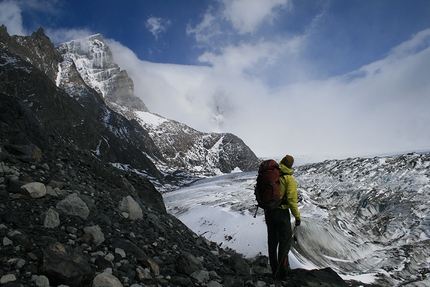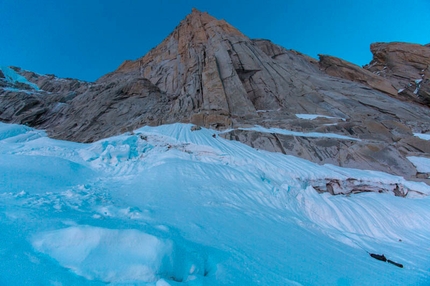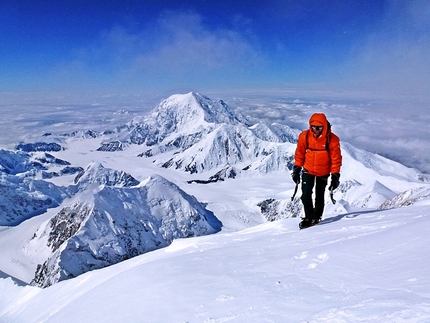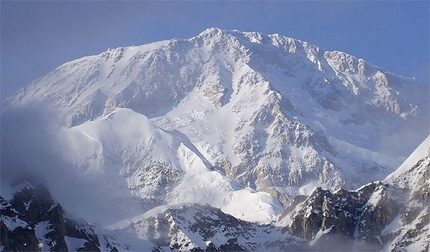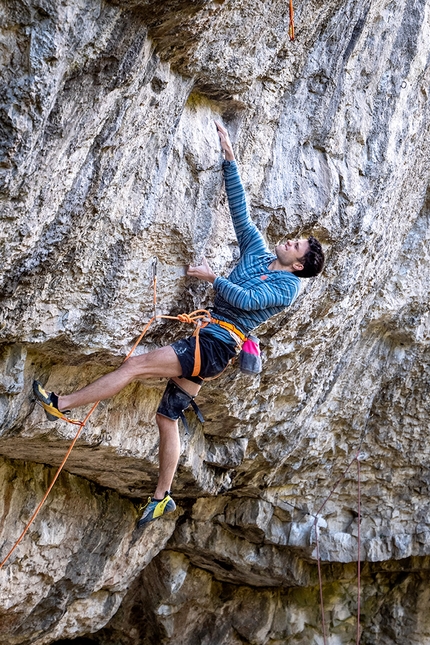Denali, Alaska: Slovak Direct repeated by David Bacci and Luca Moroni
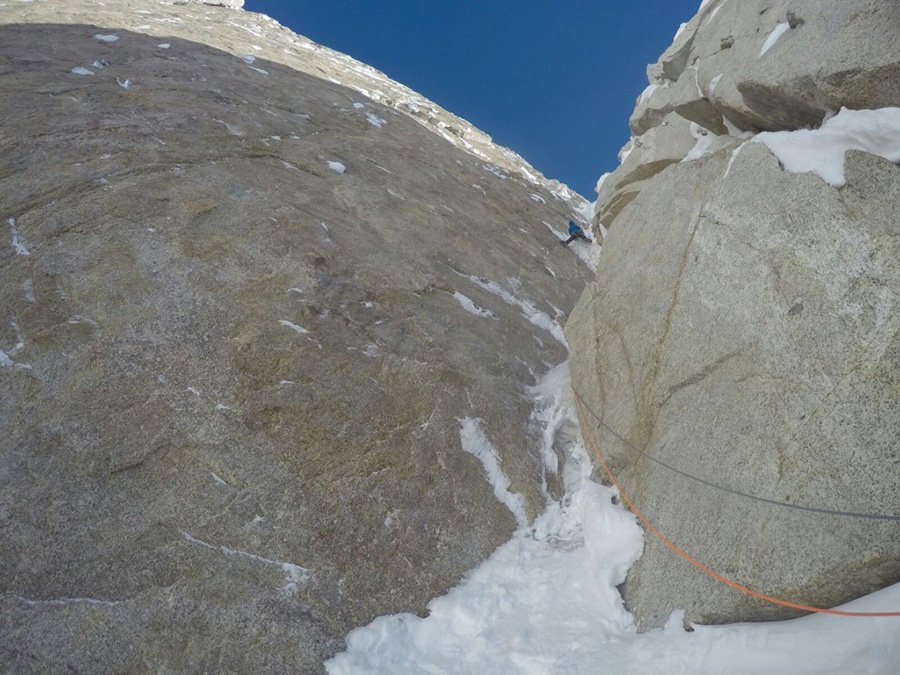
 1 / 23
1 / 23 David Bacci, Luca Moroni
David Bacci, Luca Moroni
During their first visit to America’s coldest state, the Italian Ragni di Lecco mountaineer David Bacci and his climbing partner Luca Moroni made a five-day repeat of the Slovak direct on Mount Denali, widely recognised as the most difficult climb up the highest mountain on the North American continent, also known as McKinley.
Established by the Slovaks Blajez Adam, Tono Krizo and Franticek Korl in 1984, the route is over 2800m high and offers more than 3000m of climbing through the huge south face and today, more than three decades after those famous 11 days on the mountain, it has only been repeated seven times. Of these, there is of course the absolutely amazing, crazy standout ascent carried out Mark Twight, Scott Backes and Steve House in 60 hours.
Bacci and Moroni summited after "5 days and 61 hours of non-continuous climbing" and the path that took them there - besides the acclimatisation on the normal route - obviously includes important ascents throughout the Alps as well as prestigious peaks in Patagonia such as Cerro Torre, Fitz Roy and Cerro Murallón.
Published below is the ascent report written by David Bacci. Before reading it however, it’s worth analysing the thoughts of their friend Matteo della Bordella who explains precisely why this repeat is so important: "The route in question, the Slovak Direct on Denali, is perhaps not super famous beyond the tight-knit mountaineering world, but it is in fact a milestone in mountaineering history, a route on which the world’s best have tested themselves and become famous.
We live in an age where it is difficult to comprehend the real value of an ascent, as more often than not the value of the undertaking is influenced by how the route has been comunicated, and by whom. If you’re not clued up on the mountaineering world it can prove extremely difficult to judge what is true achievement and what is nothing more than pure marketing. Well, for what my opinion is worth, this ascent really is something important.
Some may believe that, in principle, since the ascent is a repeat and not a first ascent, then it is less important than establishing a new route. If you believe this, then you’re wrong, by a long way. The hostile environment, the technical and alpine difficulties, the fact that only a handful of the best in the world had repeated it coupled with the knowledge that at one point the only way out is up, all make this an extremely psychological undertaking. Repeating a route like this is certainly more important that climbing a new route on a mountain that doesn’t offer the same level of commitment and difficulties.”
Czech Direct on Denali by David Bacci
Ever since reading stories of Jack London as a kid I had dreamt about visiting this Arctic land and its amazingly vast landscape inhabited by tough and hardy people and amazing wild animals. For years I had felt the urge to visit this place and after Patagonia in 2016 I set my course on coming here as soon as I was ready.
My passion is Alpinism and I love to combine outdoor adventures with climbing. But I needed something that really challenged me and motivated me to improve. I had read Mark Twight's Kiss or Kill a couple of years back and the story of his ascent with House and Backes of the Czech Direct on the South Face of Denali (6190m) had really inspired me for the audacity and level of commitment. This route was opened in 1984 by three Czechs Krizo, Korl, Adam, over an 11 day period. I great ascent by strong East Europeans.
As I looked at the pictures of the wall and the climb I really began to feel it was within my reach. If I managed to get strong enough, disciplined enough regarding the acclimatization, and find the right partner, then I would be able to do it. The Czech Direct is considered the hardest route up the highest mountain on the North American continent, it is comprised of 2800m of elevation gain and more than 3000 m of climbing graded Alaska 6 W6 M6 A2 ED+. Only 7 teams had repeated the route since 1986 and all were absolute aces. I felt I was being very ambitious, but sometimes you have to, otherwise you are not living to the fullest.
Time passed and my climbs in the Swedish Arctic, Karakorum, Patagonia and the Alps provided me with the confidence that I could climb hard for several days on end, I could resist intense cold without getting hurt and that I was able to commit body and mind to a climb and succeed.
Furthermore, my climbing partnership with Luca Moroni, a good friend from Varese, was developing well, we climbed some really good and long routes in the Alps such as Divine Providence and he was really motivated to get his hands on something harder beyond his backyard. Perfect, after another successful trip to Patagonia on Cerro Murallon, I was now ready for Alaska. As soon as I returned home I immediately began the preparations, getting the funding and support from my group the Ragni di Lecco who in 1961 had established the Cassin Ridge or, better still, via “Citta di Lecco” which is the ridge line immediately to the left of the Czech Direct.
I got to meet the climbers of the first ascent like Luigi Airoldi and Romano Perego who motivated me and encouraged me to take on this ascent. They said "If you go you'll succeed" and "if you are prepared you won’t be afraid of anything" as well as other stuff like "I lost three toes on it" and "it was the coldest experience of my life".
We booked flights for the 29th of May and decided to dedicate a month to it. The first 10 days would be spend acclimatizing and the rest to climb the route.
We were planning not more than 5 days on the route. Luca and I arrived in Anchorage and bought all the necessary supplies, packed our bags and after a couple of beers with a Eskimo bush pilot who somewhat emotionally told us about the fact that he had already lost three pilot friends during the first part of the year, we headed to Talkeetna to meet our pilot and fly on to Denali. We had booked with Sheldon Air Service, operated by the daughter and family of Don Sheldon who had flown the Ragni di Lecco and Riccardo Cassin in 1961.
His airplane was still in the hangar and we slept next to it. I could feel that the history of my mountainering club very much alive. We had a meeting with NP Ranger Mark Westman who had climbed the route with Jessy Huey and he gave us some beta about the approach and showed us some pictures of his ascent.
Two things worried me the most: the approach and a 30-hour day to get through the main difficulties. Mark super friendly and enthusiast psyched us up even though I do not think he believed we had a chance as “guys on their first experience in Alaska and want to do Czech direct” he also told us that there were other 4 teams that wanted to climb the Czech… 2 girls, a Piolet d’or team, 2 strong Brits and 2 Finns and us.
After a very scenic flight we landed on the Kahiltna glacier and started to haul our big sleds up the west buttress route, 70kg of gear and food each felt very heavy and it took us 5 days to reach 14k camp (4300m) I was feeling well and the glorious weather was making it almost enjoyable.
Luca was also feeling good and dragging 2 sleds instead of one. We arrived the 4th of june at 14k camp and placed our little home and dug in. The weather continued to be good for the rest of the week with no wind and almost warm temperatures. I really thought all the other teams would be climbing the Czech in that window, but I found them at 14k doing Yoga. Seemed like a waste of time. Me and Luca went up the west buttress route to 5000m then to 5500m rested a day and went for a summit push. From 14k it is about 2000m of elevation gain. However the weather changed and we had to wait another week before we could finish acclimatization.
At 5800 Luca had really cold feet and had to retreat. I continued to the summit. It was bitterly cold and about -40°c. I was feeling very well and not cold at all. My confidence on our success was getting bigger. Luca came down but after a day of rest he went back up in record time stopping just short of the summit because “I only want to reach the summit through the Czech” demonstrating serious commitment and motivation. After that the weather closed and we began our wait for a decent weather window of about 4 days that would allow us to climb the route.
The weather was extremely variable and very cold. The average temperature was -20°c and it was snowing continuously but we were confident we would get our chance. In the meantime the other teams had attempted the route at the tail of the good weather window retreating less than half way up the route. The Piolet d’or team did not even get on it and the Finnish team was stopped by pneumonia. We were the only ones left with another 12 days at our disposal.
The 21st our good friend Matteo della Bordella, now a real expert of weather forecasting predicted a high pressure from the 19th with one day of less than good the 20th and then good for at least 4 days. It was our chance. On Midnight of Monday we looked at each other and decided to go for it. The descent on the Wickwire ramp was everything you should not do in the mountains. Waist deep snow, wind slabs, seracs over our heads waiting to rumble down on us and crevasses all over the place.
After 5 hours beating trail we reached the end of the ramp, Colin Haley’s topo of the descent really helped us to navigate this terrain. We intended to climb the notch but it looked really dry so decided to climb up to the right of the Japanese colouir and see. Again in in waist deep snow we reached a rock on the ridge and all of a sudden a piton and a carabiner from the Ragni di Lecco showed us that they had passed through this point. On the other side was a colouir going down directly to the north east fork and the base of the south face. It was the original start of the Cassin Ridge. We descended the gully and two hours later reached the base of the wall and at 8 in the morning placed our little BD first light tent and rested in the tent. What a nasty approach.
We slept through the day and below this monster we were worried we had taken a too big of a challenge. Getting back to 14k camp would be hell and we felt very committed. Again we began climbing as a soon as the wall got in the shade at midnight. We quickly understood that no hard snow would help us progress quickly and we had to fight through deep snow. The fun part began with a very long traverse on a thin crust to get to the first W6 pitch. I went for the W6 pitch but it was covered with snow and a crust of rotten ice, it took a while to get through it and climbing it with a heavy pack did not help. An hour later Luca reached the belay and we continued, the climbing did not ease off, with sustained M5 pitches and some steep inconsistent snow.
We reached the first serac and snowfield where we intended to bivy at 10 in the morning after having climbed for more than 10 hours. We placed our tent below the Bergschrund hopefully protected from anything falling from above. The weather changed as predicted and it started to snow. We felt tired and decided to rest before the “longest day”. It cleared in the morning again as predicted by Matteo. And at 6am we continued our movement upwards. As we began to climb every 60 meters appeared a nice BD ultralight camalot clearly signs of a hasty retreat from the wall.
With them we integrated our rack. The terrain was now much steeper and sustained M5-M6 pitches with bad protection led us to the ramp. The terrain was very impressing with a gigantic blank wall just above our heads and the safety of the ground far below. Luca masterfully led his block taking me to the base of the ramp, which was now pouring spindrift over us.
We had seen this scene in Houseman and Bullock’s video on their ascent and we were repeating their quotes: “big spindrift nick!” “this is amazing!”. Nonetheless, I continued up the ramp on some great ice climbing pitches, especially the overhanging W6 corner. A last mixed m6+ pitch led to the rock wall with the aid section. I relaxed for a while and belayed Luca on it took us another hour to get through it I jumared with the heavy backpacks.
Luca set out on a traverse to the left on very poor and snow covered rock that required a lot of swearing to clean. I followed and we reached a large 60deg snowfield to get to big Bertha the huge serac that marks our mid point on the wall. We continued through deep snow reaching the last rock wall after 22 hours of climbing. At that point unexpectedly Luca sat down and said he was completely exhausted and could not move any further and do anything and was terribly cold. We were exhausted and I could not see any bivy spot at hand, getting over the last rock wall seemed too hard. We had to stop.
Luca we his last flinch of energy saw a point were we could bivy but I claimed it was too icy and slopy to pitch our tent. Nonetheless I downclimbed and took a look. It was possible to dig a platform for the tent. We were saved! I shouted to Luca to continue brewing something warm as it would give him some energy back. I placed the tent and we settled in our sleeping bags after forcing down some warm tea and food.
The next morning we realized where we were, next to Big Bertha on a very small outcrop on an endless slope the abyss below us. Luca had recovered his strength and we rested in the sun. At 4pm we set out again, we had already packed ropes and gear away but as we reached the rock wall that seemed very easy we realized it was not. It took us 2 and a half hours to get through these last M5 pitches and onto the last snowfield. We were now at 4500m and at we had passed the point of no return.
The difficulties eased and we knew it was easy terrain all the way to the top. However the snow was knee deep and breaking trail at altitude and after so many hours of climbing would be difficult and exhausting. We broke trail 100m each until we reached the Cassin ridge in the afternoon, we had been on the go for at least 5 hours and continued after a brew on the ridge line. We almost thought we could reach the summit that day.
After another 6 hours breaking trail we were still 800m below the summit at 5400m. As Luca walked unroped I heard two very loud Gun Shot noises coming from beneath us. It woke us up from our trance, what was it? A Cornice? A Wind Slab? We continued but after another 200m the snow got even deeper and we decided to stop for another bivy. At 5600m we started to dig a platform and Luca found an old red woolen sock in the ice. Perhaps from the Ragni?
We had a very cold night, inside the sleeping my watch measured 10°c. Too cold to sleep so we shivered away the night. In the morning the weather had changed just as forecasted. We continued in deep powdery snow in no visibility. I thought about the Giri-Giri boys following the tracks of their friends until these disappeared as did they friends
The terrain was easy but we were exhausted and we were unroped any mistake could easily mean death. At 6000 we reached the top of Pig Hill and the last ridge of cornices to get to the summit.
We left our backpacks by now void of any food and fuel and continued to the summit. Every 10 steps we had to stop to catch our breath but at 4 pm of the 23rd of June we reached the summit after 5 days and 61 non-continuous hours of climbing. We were elated and extremely happy also exhausted so we decided to begin our descent immediately.
5 hours later we reached 14k and our tent. Our mission was accomplished and our first trip to the Alaska range had exceeded all our expectations.
A big thanks to Ragni di Lecco, Adidas Outdoor, CAMP Cassin CAI Lecco and CAI Varese and all my friends, Matteo DB, Samuele Bignami, Caterina Tixi and my Family.
| Expo.Planetmountain | |
| C.A.M.P. | |
| www | |
| FB Luca Moroni | |
| FB David Bacci | |
| FB Ragni di Lecco | |
| ragnilecco.com | |



 Copia link
Copia link

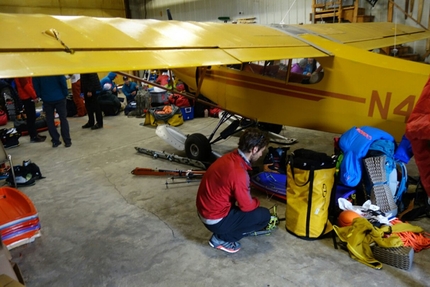
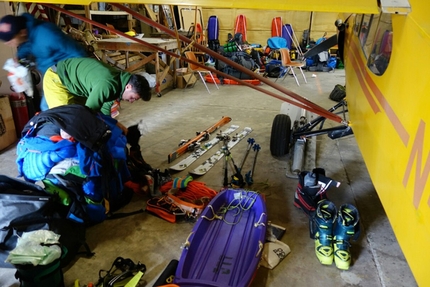
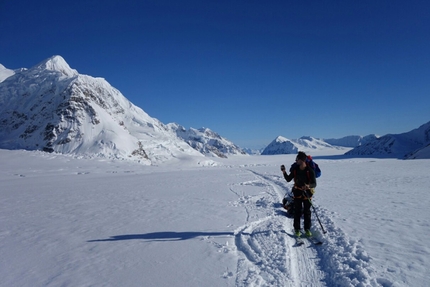
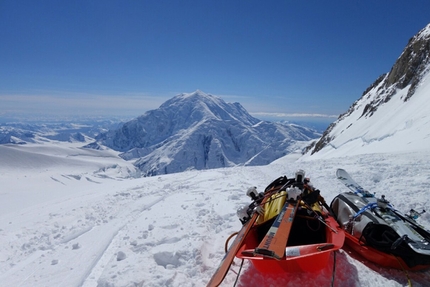
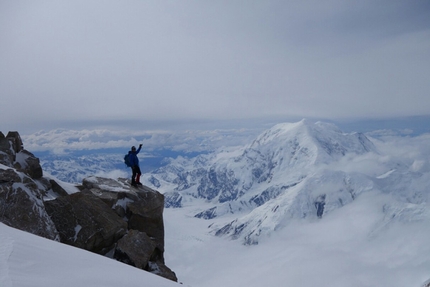
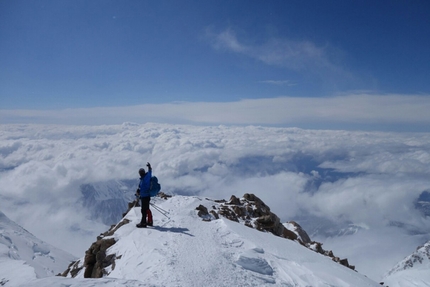
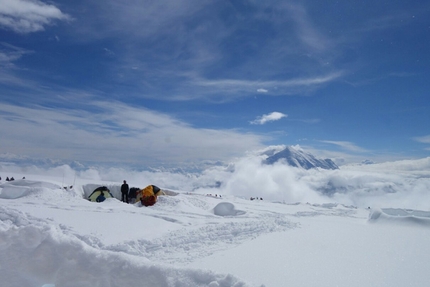
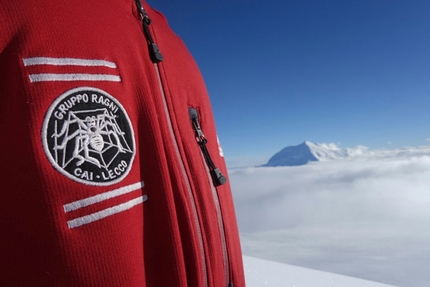
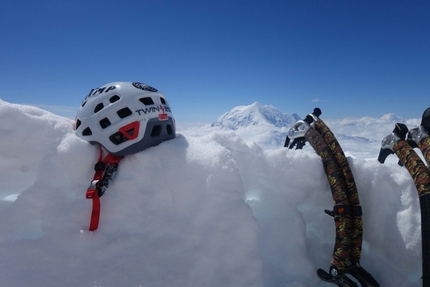
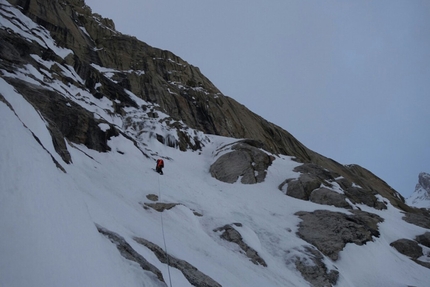
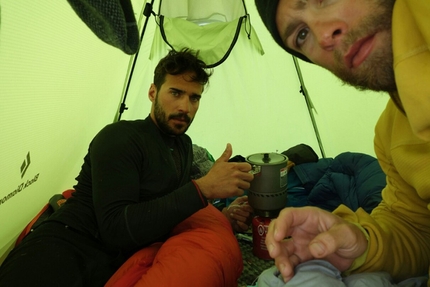
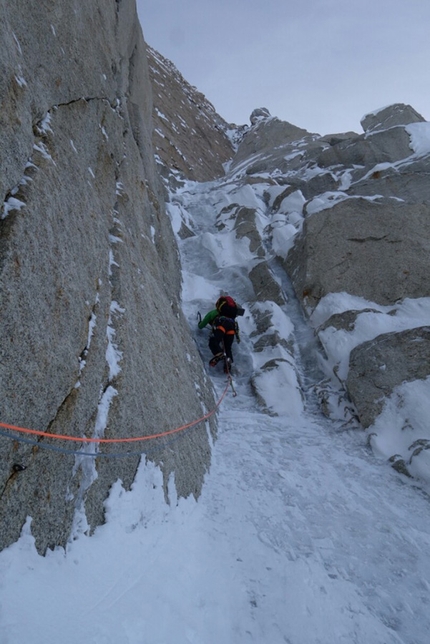
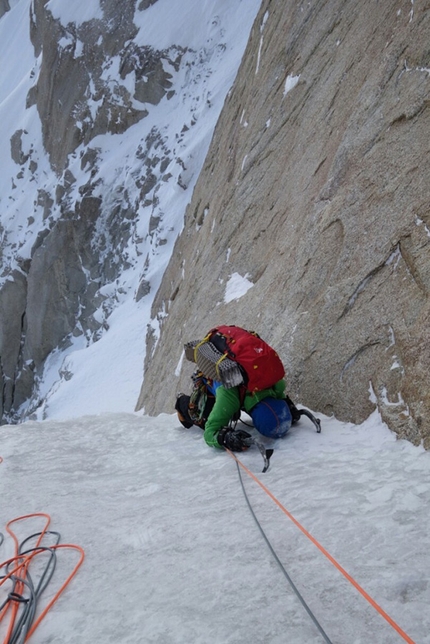
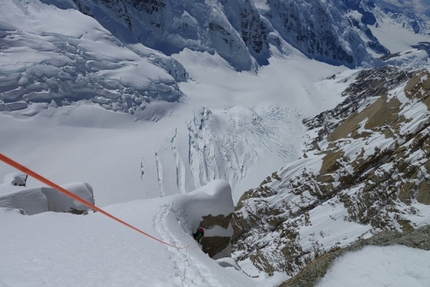
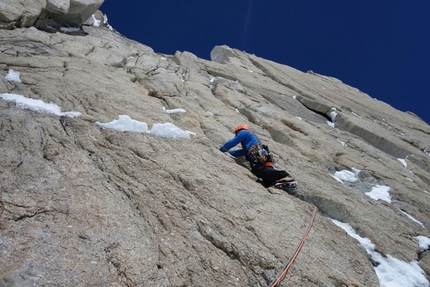
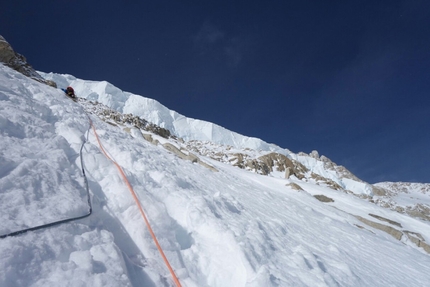
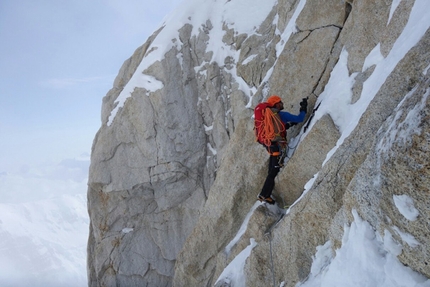
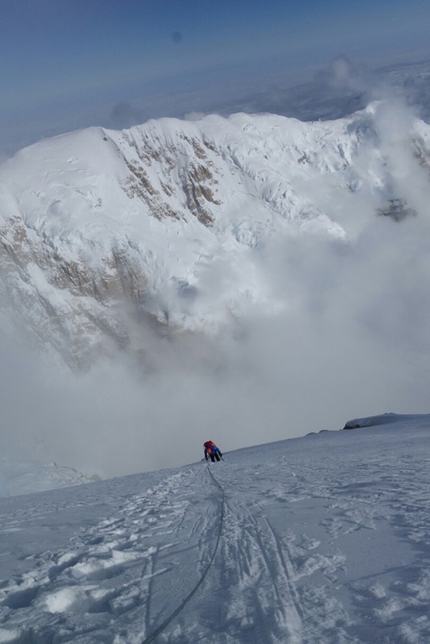
 See all photos
See all photos